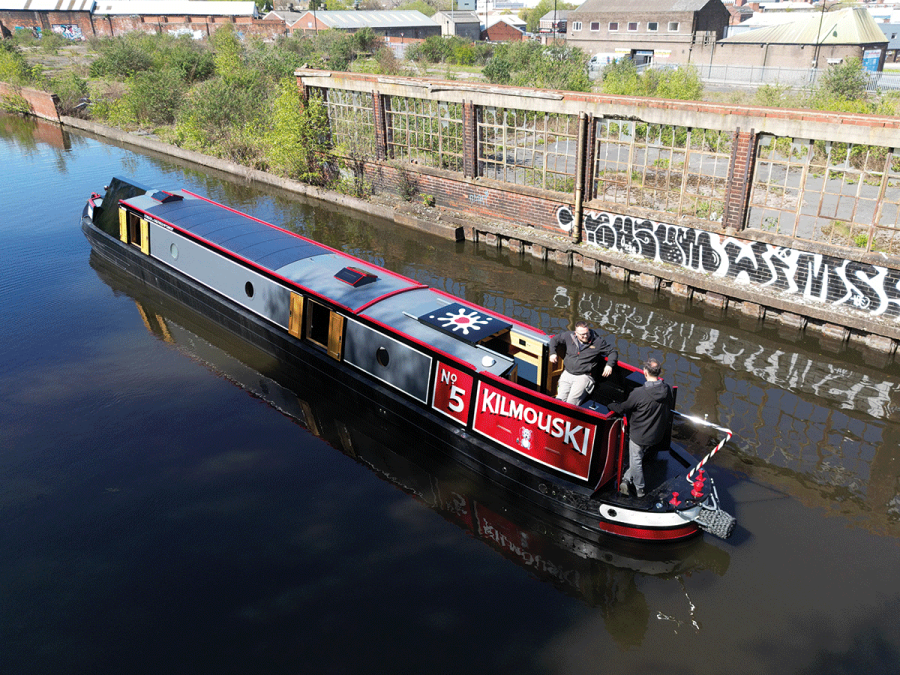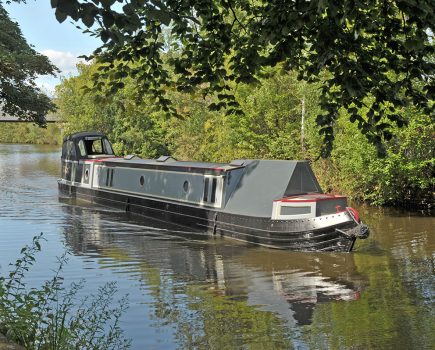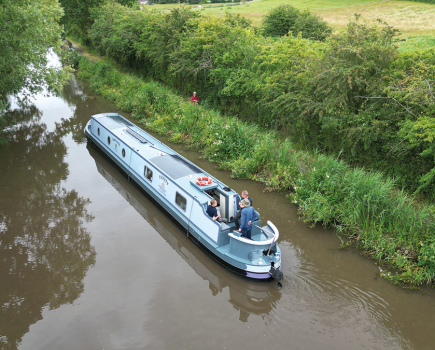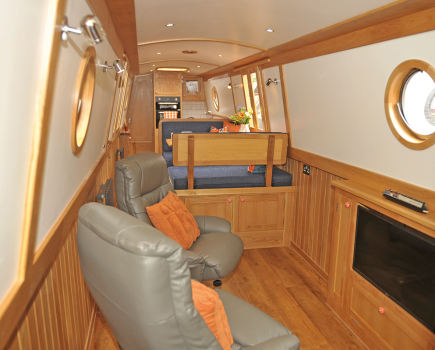Making the best use of space is one of the most important things when it comes to designing your boat – and part of the equation is the balance between inside space and outside.
Words by Adam Porters | Pictures by Andy Annable
In recent years, we’ve seen more and more boats without a well deck, with the owners preferring instead an extended cabin, to increase the amount of internal space. Michelle and Peter McDermott, the owners of this boat, Kilmouski, have had boats for years, weren’t fans. “What do you use a well deck for?” asks Michelle. “It’s just a storage area for bags of rubbish”.
The simplest way to extend a cabin is just to carry on the cabin sides to where the forward edge of the well deck would be, and then have a bulkhead with maybe a window or a set of small doors at the bow. The resulting shape isn’t to everyone’s taste, though, and among the people who dislike the look is the well-known shell builder, Jonathan Wilson, who flatly refuses to build such a boat. The solution is to take inspiration from the shape of old working boats – so this boat has a fore cabin and a tipped-in section (which will soon be covered in traditional cloths) which looks like the covers over an open hold. But while the outside looks very traditional, the interior and the technology on board are anything but. It’s been fitted out by Finesse, and has their own electric drive system and their signature sleek modern interior.
EXTERIOR
If you’re going to have a boat with traditional features, you might as well go the whole hog. And this boat definitely does that. It’s a 61ft 6in sheerline Josher, so the gunwale line has a pleasing sweep which you can only really appreciate at a distance, and the bow has the double Josher curves and a substantial stem post. There are scrolls in the cants and the handrails, and the entire handrails protrude slightly, as they would have done if they were made of wood. There are rivets along the length of the boat, and a boatman’s beam over the roof. The panels at the stern are recessed. When we visited, the tipped in section at the bow was still awaiting its cloths. It will look even more traditional when they arrive, and have their ropes and signwriting added. Speaking of signwriting, Andy Russell has done a great job with the lettering and artwork. The boat’s name, Kilmouski, comes from the name of a cat in an episode of Midsomer Murders – and Andy has painted a mouse who appears to be about to blow himself up with TNT! It’s the sort of thing that would give you a smile every time you saw it. The colour scheme uses black and grey, which looks dramatic and manages to be both traditional and contemporary at the same time.
Away from aesthetics and on to practicalities, there’s a vast locker at the bow, which can be accessed through the hatch at the nose and on top of the fore cabin. There’s access to the bow thruster tube here, but it also has a false floor to make the space more useable. There are even power sockets inside, so you could charge electric bikes for example.
The stern is a semi-trad, which might seem an odd choice for a boat with such a traditional exterior. But without a well deck, the boat needs some outside space, which this deck provides. And with stern doors, it looks like a trad from a distance. There are lockers both sides of the deck for storage, and there’s a tall locker with a door hinged at the bottom, giving somewhere to keep mooring stakes and suchlike.
The engine boards lift in two sections, electrically. The engine hole needs to be quite long to fit in the electric motor, generator, and batteries – but it means there’s also room down here for the electrical cupboard, housing the inverter, solar controller, and other bits of kit. It means that while the long stern steals a foot or so from the interior, it gives it back because you’re not losing a cupboard to the electrics.
LAYOUT AND FITOUT
This is a reverse layout boat, with the galley at the stern. Next comes an open plan saloon, followed by a walk-through shower room. The cabin is at the bow, with the bed occupying the tipped in section.
The fitout uses oak tongue and groove below the gunwales, with painted panels on the cabin sides – with the grain of the wood still showing through. All the trim is oak, along with the furniture. As we’ve come to expect from Finesse, everything is built to the highest standards with some excellent joinery on show. The floor is hardwearing Karndean, in a pale oak finish.
GALLEY
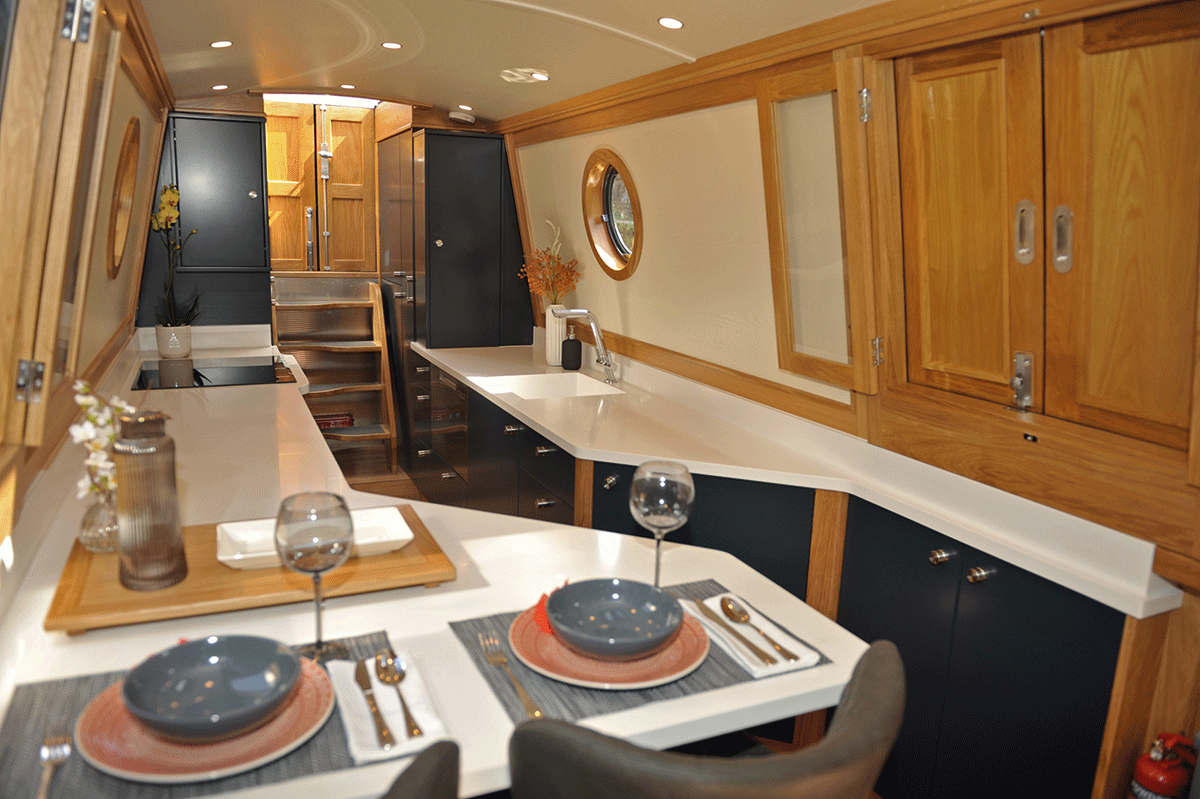
A set of space-saving steps leads down from the stern deck, so you need to make sure you start with the correct foot. Alongside are full height cupboards, but with split doors so the top half can open when the steps are in place. The steps lift out if you need more access. One of the cupboards has a heated towel rail inside, to dry off wet coats. Next comes a narrow full-height pull-out unit on one side, and a narrow cupboard with shelves on the opposite side. One of the shelves carries a toaster, and pulls out for use.
All the cupboard doors are painted blue. They’re spray-painted in Finesse’s workshop, and have a lovely finish. The units are topped with a Corian worktop – again made in house; Finesse sent its staff on a Corian training course, to avoid having to bring in an outside company whose schedule may not fit in with the build progress. Set into the worktop is a moulded sink, with a stainless steel base. There are low-level lights in the kick boards.
This galley is very well equipped. There’s a Bosch induction hob, and an AEG electric oven. There are two full-size fridges, one of which has an ice box. There’s also a drawer dishwasher by Fisher and Paykel.
One run of units broadens out into a breakfast bar, which has a couple of stools. In a clever move, the resulting triangular unit pulls out to reveal a washing machine, which makes use of the otherwise dead corner. On the opposite side of the boat, there’s a useful under-gunwale can cupboard. There are side hatches both sides, with glazed inner doors, making the breakfast bar a very pleasant place to sit – and a couple of wooden infill sections have been made to extend over the corridor, meaning you can seat four people. There’s also a glazed pigeon box in the roof.
SALOON
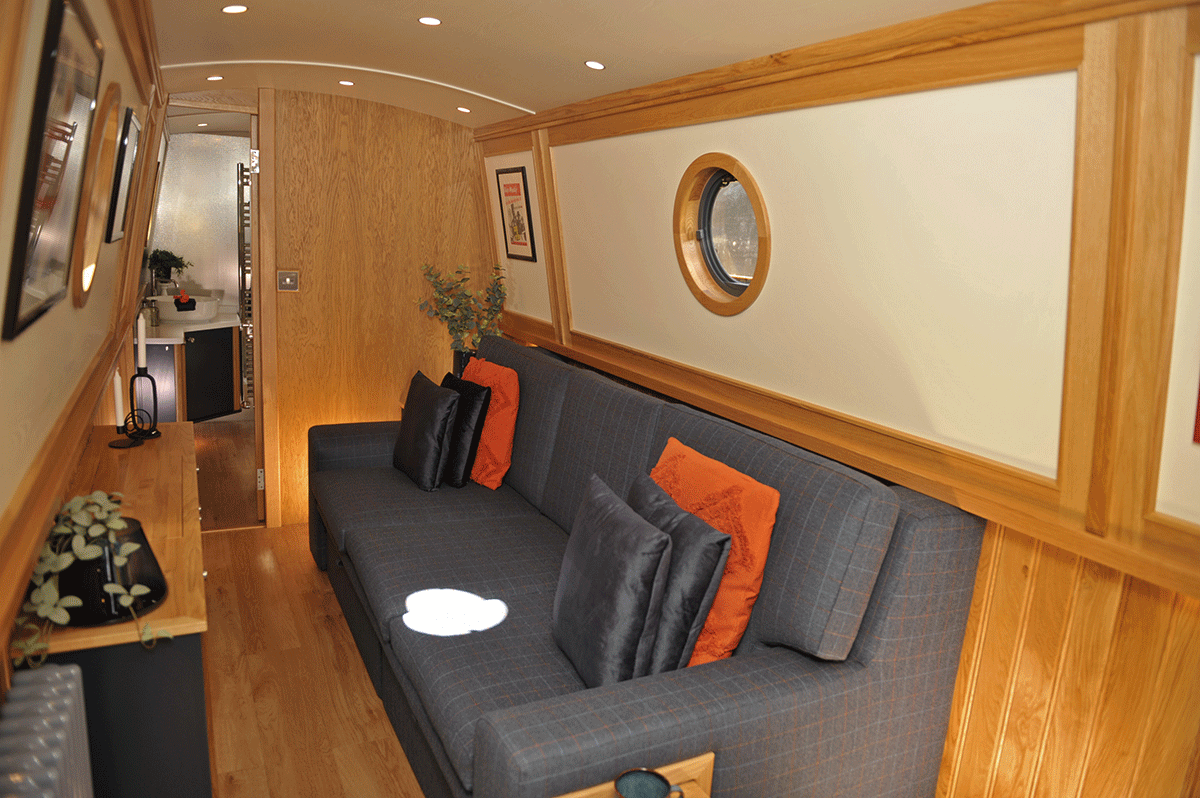
The saloon is dominated by a very large sofa, which has been made in-house by Finesse to specifications from the owners. It’s deep enough to curl up on in comfort, and also converts into a guest bed. The base pulls out and there’s a mattress stored behind, making it more comfortable than a normal sofa bed. A very neat addition is a flip-up shelf in the arm, big enough to hold a mug. The stylish blue fabric with a check pattern was commissioned by the owners from a mill in Bradford, because they were struggling to find exactly what they wanted; although it sounds expensive, Michelle says it proved very cost effective.
Opposite the sofa is a sizeable under-gunwale unit, which offers some storage space and a tv which rises electrically. The owners don’t watch a great deal, so didn’t want the tv on display all the time. There’s some more storage space at the far end of the sofa, where there’s a low unit.
CABIN
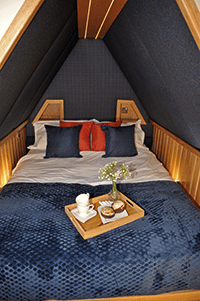 This is a lovely, calm, relaxing space. On the forward bulkhead is a large wardrobe with hanging space at the top, and drawers of different sizes below. There’s an extra little cupboard tucked in below the gunwale with a socket inside, to house a hairdryer.
This is a lovely, calm, relaxing space. On the forward bulkhead is a large wardrobe with hanging space at the top, and drawers of different sizes below. There’s an extra little cupboard tucked in below the gunwale with a socket inside, to house a hairdryer.
The bed is in the tipped in section at the bow, and the sides plus the forward bulkhead have been fully upholstered, giving a really cosy feel to the space. The same blue fabric with a check pattern that we saw on the sofa has been used on the bulkhead – with a plain version on the cabin sides (it would have been impossible to match the lines of check, if it had been used on the sloping walls).
The bed is quite low, maximising headroom under the sloping walls, but it still has drawers in the end of the base. The water tank takes up much of the rest of the bed base. There’s a lighting feature in the small amount of flat ceiling above the bed, and there are some neat cubby holes in the forward bulkhead. The owners say the bed is a revelation, after the short cross bed in their previous boat.
There are side doors both sides, with bi-fold glazed inner doors. These also act as escape routes, although you probably wouldn’t want to use them to enter or exit the boat on a regular basis. Light comes from a glazed pigeon box in the roof.
SHOWER ROOM
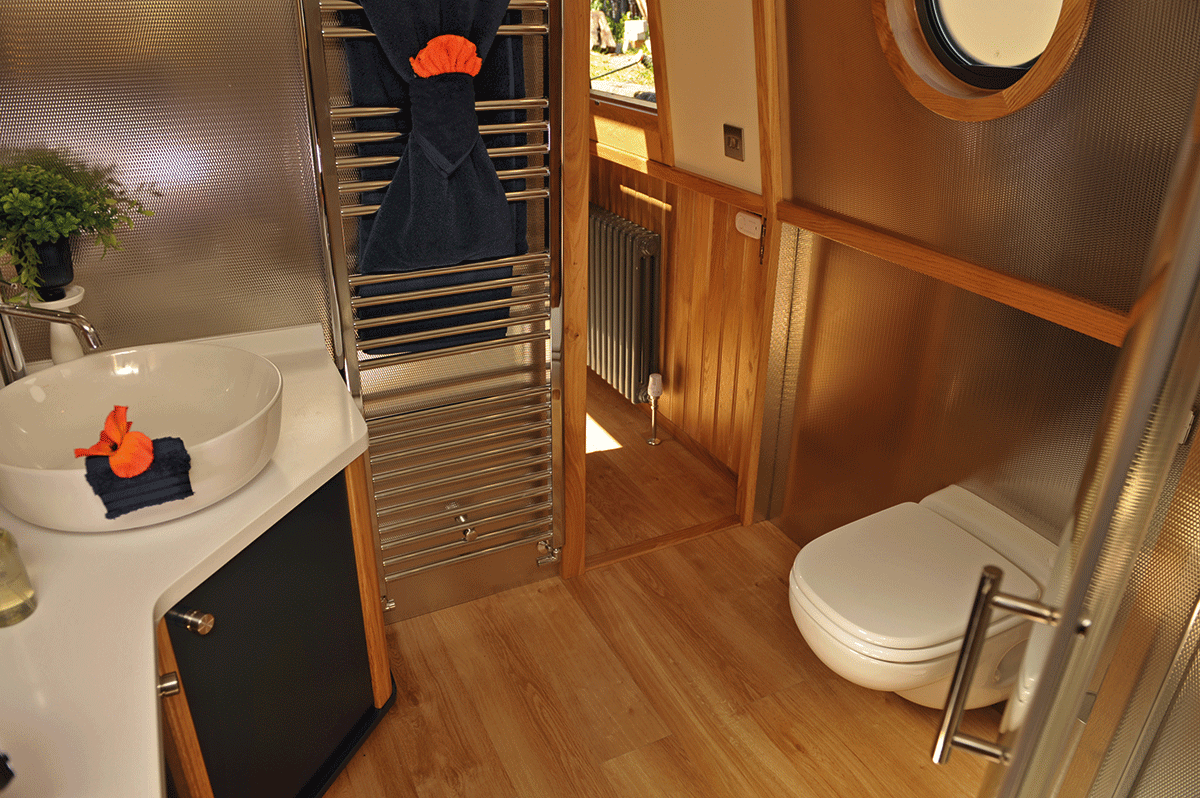 This room is given a real wow factor by the walls being clad in pressed stainless steel sheets. They have a textured finish, which means they glint in the light and avoid the feeling of being too clinical. And I’m told that even though the walls are metal, there’s been no sign of condensation. The shower cubicle is a generous 900mm quadrant, and there’s room for some storage alongside. This boat doesn’t have mushroom vents in the roof (it doesn’t need them because there’s no gas or stove, and the pigeon boxes provide enough high level ventilation) so there’s a powerful extractor fan fitted high up in the cubicle, and vented to the outside.
This room is given a real wow factor by the walls being clad in pressed stainless steel sheets. They have a textured finish, which means they glint in the light and avoid the feeling of being too clinical. And I’m told that even though the walls are metal, there’s been no sign of condensation. The shower cubicle is a generous 900mm quadrant, and there’s room for some storage alongside. This boat doesn’t have mushroom vents in the roof (it doesn’t need them because there’s no gas or stove, and the pigeon boxes provide enough high level ventilation) so there’s a powerful extractor fan fitted high up in the cubicle, and vented to the outside.
There’s plenty of storage, with an under gunwale cupboard, and a unit which carries a large white basin. A full height heated towel rail means there’s lots of hanging space too.
The toilet is a macerating unit by Vetus, which floats off the floor. The holding tank is at the stern, meaning there’s a significant run of pipe between the two which could be bad news if there’s a hard-to-find blockage.
TECHNICAL
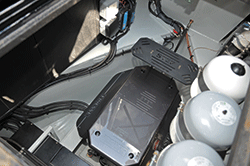 This is a serial hybrid boat – meaning the propulsion is entirely by the electric motor, but there’s a diesel generator to charge the batteries. Finesse has become something of a leader in this field, putting together its own combination of a motor which they put together themselves, a generator, and a battery bank, all linked by their own control system – and they deal directly with the manufacturers. This avoids the problem that there is an almost infinite number of combinations of electric motors, batteries, and generators – and it can be difficult to ensure they all work together in exactly the best way. The electric motor is a 48-volt Permanent Magnet AC type, rated at 25kw at its peak, and able to deliver 15kw for a continuous two hours and 96 per cent peak efficiency at cruising speeds. It has no belts, no gears, and needs no maintenance, and comes with a ten-year warranty. The bow thruster is the brushless model by Vetus, which can run in a graduated way, and for a long period of time if necessary.
This is a serial hybrid boat – meaning the propulsion is entirely by the electric motor, but there’s a diesel generator to charge the batteries. Finesse has become something of a leader in this field, putting together its own combination of a motor which they put together themselves, a generator, and a battery bank, all linked by their own control system – and they deal directly with the manufacturers. This avoids the problem that there is an almost infinite number of combinations of electric motors, batteries, and generators – and it can be difficult to ensure they all work together in exactly the best way. The electric motor is a 48-volt Permanent Magnet AC type, rated at 25kw at its peak, and able to deliver 15kw for a continuous two hours and 96 per cent peak efficiency at cruising speeds. It has no belts, no gears, and needs no maintenance, and comes with a ten-year warranty. The bow thruster is the brushless model by Vetus, which can run in a graduated way, and for a long period of time if necessary.
There is a 36kwh lithium-iron battery bank, which has a custom canbus battery management system. This is a huge amount of available power. The rough equivalent in 12-volt lead acid batteries would be 2800Ah – although as lead acids should only be discharged to fifty per cent, you’d really need 5600Ah. When you consider that a typical set up is four 110Ah batteries, you get the comparison.
The generator is a Kohler 9KVA unit. There are also eight 165 watt solar panels on the roof, to help keep the batteries charged. A 10KVA Victron Quattro inverter charger provides a 240-volt supply. There’s also a step down system to 24 volts for the lighting and the loo. Everything else operates on mains voltage. The lights are all dimmable, in zones.
The whole system can be monitored remotely, and Finesse can even send updates to all the boats fitted with it. It’s remarkably clever, and means that Finesse can also analyse how efficiently the boats are operating. Ricky Lee, from the firm, says that on average, three hours of cruising needs just an hour of running the generator, even if there’s no input from solar. With solar, that time can be reduced further. That means that an electric boat like this uses significantly less diesel and is therefore significantly greener, than a diesel powered boat.
Central heating comes from a pressure jet boiler, which can be remotely operated through a Nest thermostat. There’s also a solar dump system, so if the batteries are fully charged, any solar input is used to heat the water tank.
ON THE WATER
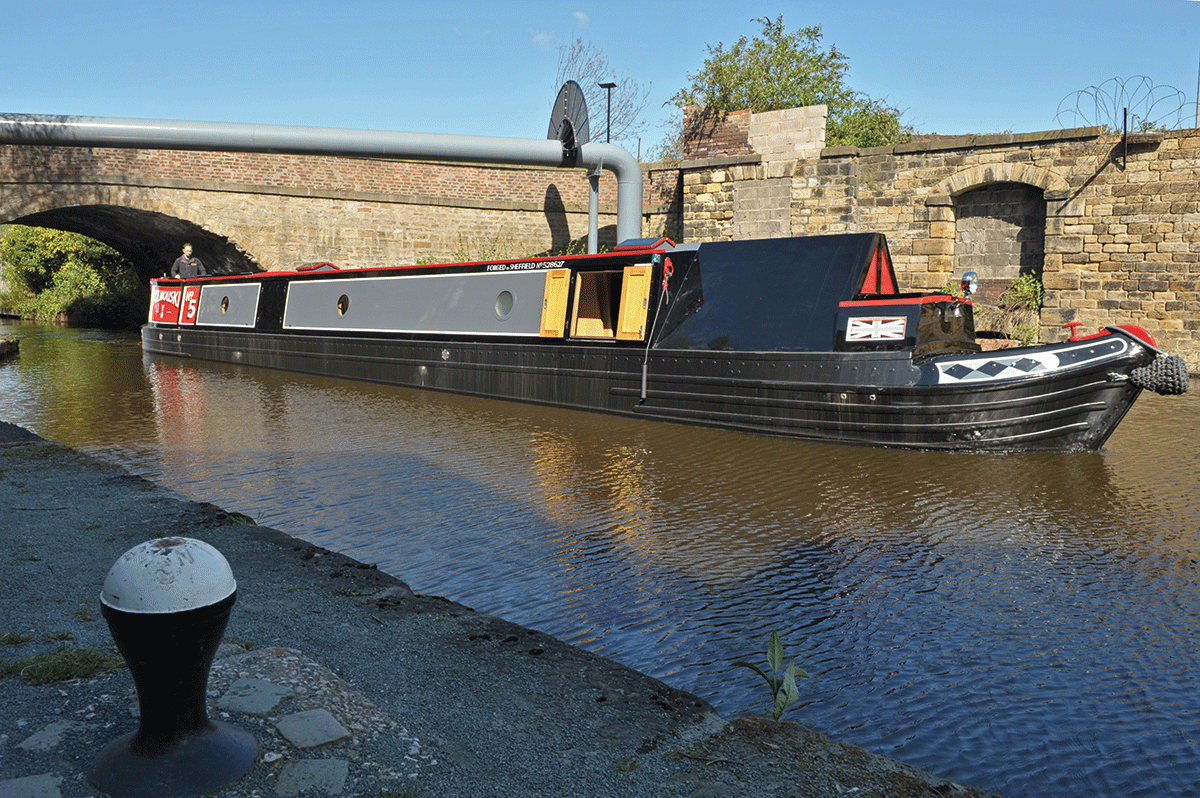
It was the quietness of the motor which attracted Michelle and Peter to electric drive, when they took a previous Finesse boat for a test run. The Finesse motor is a particularly quiet one, meaning you can hear birdsong or people talking on the towpath, and the sound of water round the prop. The generator is in the engine hole, but is in a sound reduction box, so even that doesn’t intrude too much if you want to run it as you cruise.
At cruising speed, you’re using only a small proportion of the available power which means you feel confident that this boat could cope with rivers. And there’s something special about being able to control the motor with a tiny yet perfectly formed metal control lever.
Jonathan Wilson boats always handle superbly. Its long bow and long swims at the stern mean it goes where it’s pointed and turns very well.
CONCLUSION
This is a really lovely boat. The shell has impact, the technology is advanced yet tried and tested, and the fitout is extraordinarily well done.
Finesse says its electric boats start at £220,000. But this is not a standard electric boat, so will have cost quite a bit more. The shell is anything but standard, and it’s a boat with a lot of fitout and a lot of equipment; a serial hybrid system is expensive, not least because of the batteries.
This boat not only manages to combine traditional and modern, it manages to have a sleek contemporary interior which still feels welcoming, comfortable and homely. That’s not an easy trick to pull off. And what’s more there’s great use of space throughout. The tipped in section at the bow not only looks great from the outside, it looks and feels great from the inside too..
THE OWNERS
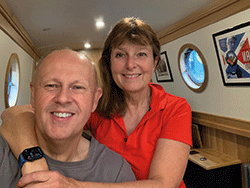 Michelle and Peter McDermott have a long boating history – in fact this is their fifth boat. They started with a 27ft GRP cruiser, then had two narrowboats from Pat Buckle, each longer than the previous boat. Some 20 years ago they commissioned a 62ft boat from Fernwood, which they sold in 2016.
Michelle and Peter McDermott have a long boating history – in fact this is their fifth boat. They started with a 27ft GRP cruiser, then had two narrowboats from Pat Buckle, each longer than the previous boat. Some 20 years ago they commissioned a 62ft boat from Fernwood, which they sold in 2016.
Michelle worked for Marks and Spencer many years ago, which is why she knew about the mill in Bradford. More recently, the couple had a company which imported food ingredients; they sold the firm in order to take a very early retirement, and so Michelle could go back to university to study family history and coats of arms. She’s the genealogist for Aston Martin, which was the subject of her dissertation.
The couple say they like to have the best quality they can, which is how they ended up commissioning their boat from Finesse. “They really are the Rolls Royce of the boating world” says Peter.
Specification
Length: 61ft 6in
Beam: 6ft 10in
Shell: Jonathan Wilson via Finesse
Style: Semi-trad
Layout: Reverse
Berths: 2+2
Fit-out: Oak and painted panels
Electric motor: 15kw continuous PMAC / www.finesseboats.co.uk
Generator: Kohler 9kva / www.kohlerpower.com
Bow thruster: Vetus brushless / www.vetus.com
Inverter: Victron 48 10kw / www.victronenergy.com
Dishwasher: Fisher & Paykel DD60SCHX9 / www.fisherpaykel.com/uk / £1,030
Fabric: Clissold / www.clissold.co.uk – £poa
£300,000
CONTACT
Finesse Boats
Victoria Boatyard, Sussex Street, Sheffield, S4 7YY
07852 201375
sales@finesseboats.co.uk
www.finesseboats.co.uk
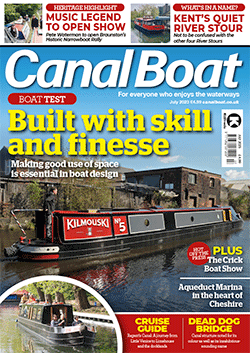 As featured in the July 2023 issue of Canal Boat. Buy the issue here
As featured in the July 2023 issue of Canal Boat. Buy the issue here

